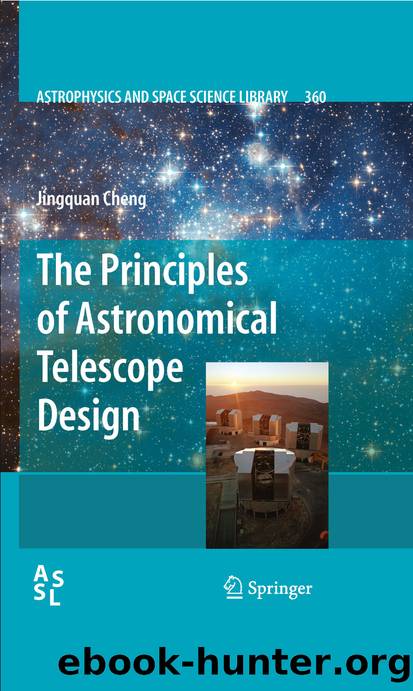The Principles of Astronomical Telescope Design by Jingquan Cheng

Author:Jingquan Cheng
Language: eng
Format: epub
Publisher: Springer New York, New York, NY
5.3 Space Telescope Projects
5.3.1 Hubble Space Telescope
The first major space telescope project was the Hubble Space Telescope (HST). The project, also named the Large Space Telescope (LST) and Space Telescope (ST), was proposed by the National Aeronautics and Space Administration (NASA) in the 1960s. In the beginning, the telescope size was not fixed. An early test tube structure made by Boeing Inc. had a 3 m aperture size. The 2.4 m aperture size was finally selected in 1975 as a result of cost analysis. At that time, the budget for a 3 m telescope was $334 M, for a 2.4 m one $273 M, and for a 1.8 m one $259 M. The space telescope plan was formally approved by the US Congress in 1977 with a total budget of $425 M to $475 M. The European Space Agency (ESA) also joined the project and shared 15% of its cost.
Along with the project development, the cost went up rapidly. By 1985, the HST budget reached $1.175B. The cost reached $1.6B when the telescope was ready for launch. The HST launch was delayed because of the space shuttle disaster in 1986. The HST was put into a low earth orbit in 1990 with a total cost of $2.35B. The HST operational cost is about $230 M per year (Petersen and Brandt, 1995).
The HST telescope optics was made by the Perkin-Elmer Company. The company won the contract with a very low bid of $95 M. However, when the optical components finished in 1984, the company submitted a claim of $300 M, a number far above the bid price. The company also claimed that the components reached a much better accuracy than the specification required.
However, it was just this optics which gave the telescope a very poor image quality after launch. The HST optics suffered from serious spherical aberrations. During the manufacture of the HST primary mirror, a combined primary and secondary mirror test was not performed. The primary mirror was tested simply using nulling lens optics. Unfortunately, the primary null-corrector was misplaced by a very small distance of 1.3 mm so that the outer edge of the primary mirror was over-polished. The solar panels of the HST also had thermal caused vibration problems.
Immediately after launching of the HST, a special panel was formed to investigate this spherical aberration problem. In 1993 special correction optics was added to the HST during the first shuttle service mission for compensating spherical aberrations. In this mission, new solar panels were used in the telescope. To date, three additional service missions in 1997, in 1999, and in 2002 were performed for the HST. During these missions, three guiding gyros, new focal instruments, and a cooler system were installed.
The HST is a 2.4 m space telescope with a honeycomb fused silica primary mirror of 829 kg. The mirror was formed by fusing together five mirror components, the upper and bottom plates, the inner and outer rings, and the honeycomb grid (Figure 2.18). It is light in weight and high in stiffness.
Download
This site does not store any files on its server. We only index and link to content provided by other sites. Please contact the content providers to delete copyright contents if any and email us, we'll remove relevant links or contents immediately.
Whiskies Galore by Ian Buxton(40329)
Introduction to Aircraft Design (Cambridge Aerospace Series) by John P. Fielding(32338)
Small Unmanned Fixed-wing Aircraft Design by Andrew J. Keane Andras Sobester James P. Scanlan & András Sóbester & James P. Scanlan(32141)
Craft Beer for the Homebrewer by Michael Agnew(17445)
Turbulence by E. J. Noyes(7037)
The Complete Stick Figure Physics Tutorials by Allen Sarah(6638)
Kaplan MCAT General Chemistry Review by Kaplan(6053)
The Thirst by Nesbo Jo(5785)
Bad Blood by John Carreyrou(5768)
Learning SQL by Alan Beaulieu(5410)
Weapons of Math Destruction by Cathy O'Neil(5036)
Man-made Catastrophes and Risk Information Concealment by Dmitry Chernov & Didier Sornette(4735)
iGen by Jean M. Twenge(4702)
Digital Minimalism by Cal Newport;(4540)
Life 3.0: Being Human in the Age of Artificial Intelligence by Tegmark Max(4507)
Audition by Ryu Murakami(4098)
1,001 ASVAB Practice Questions For Dummies by Powers Rod(4038)
Electronic Devices & Circuits by Jacob Millman & Christos C. Halkias(4027)
Pale Blue Dot by Carl Sagan(4001)
